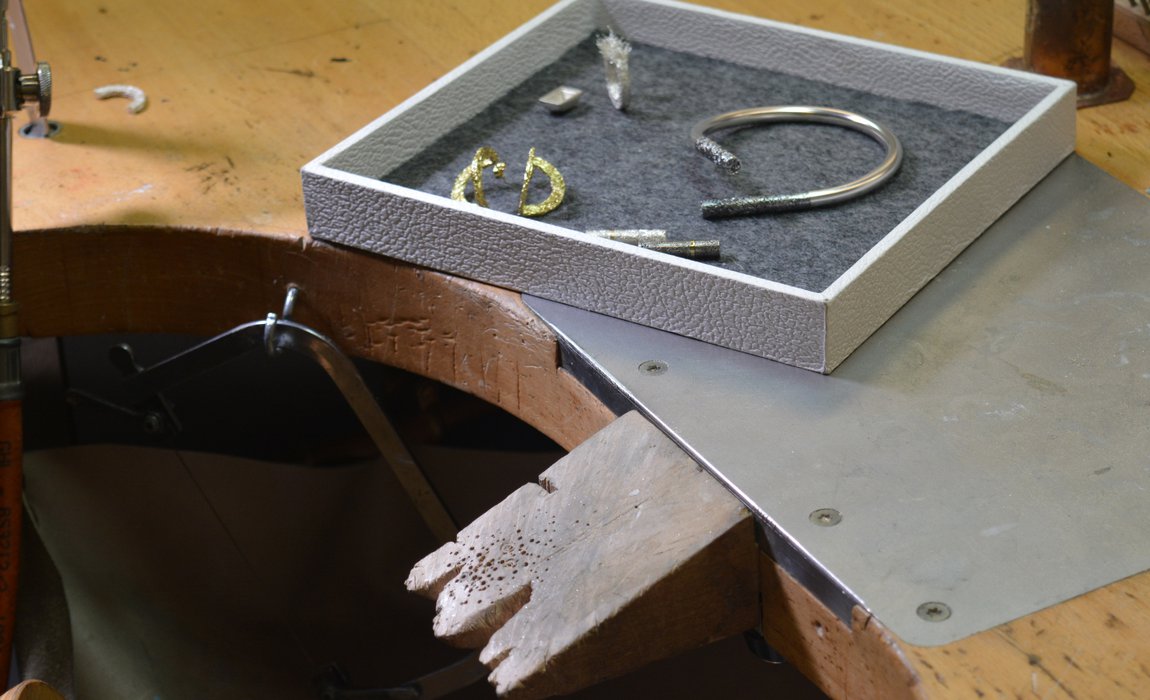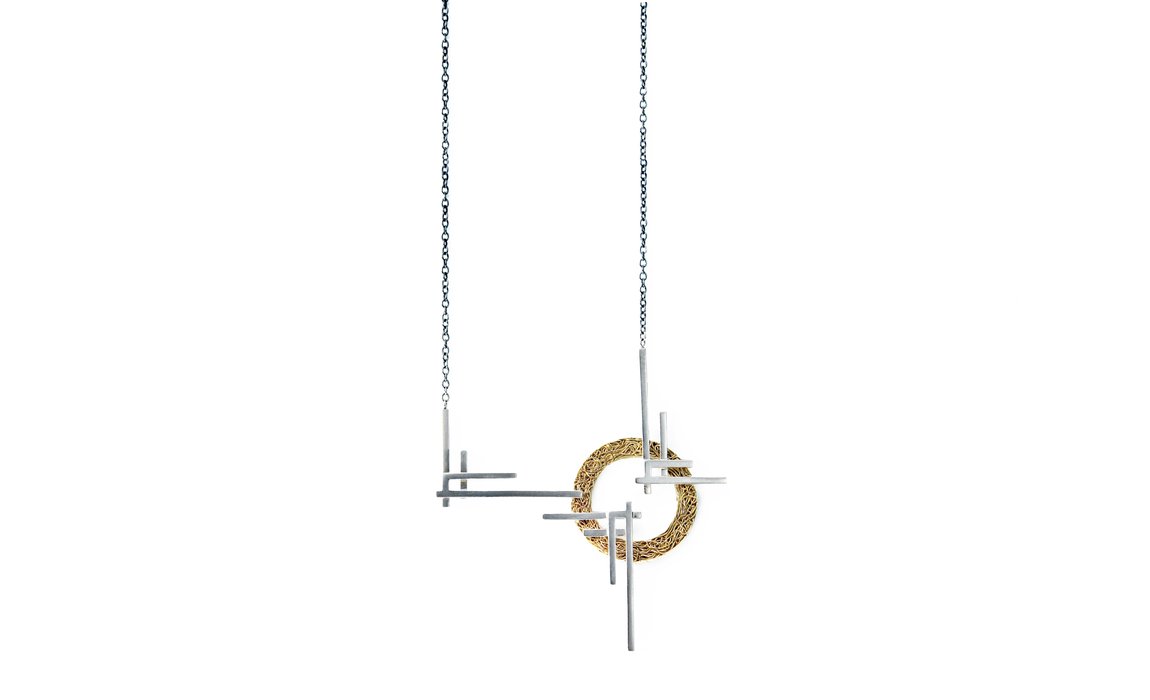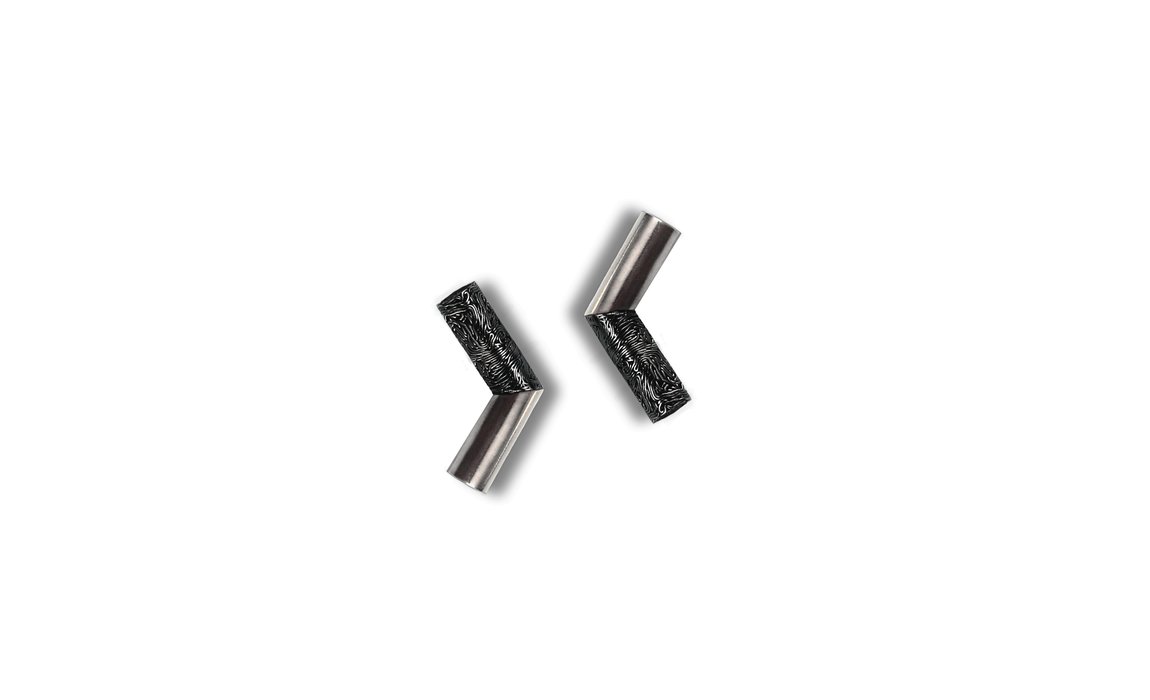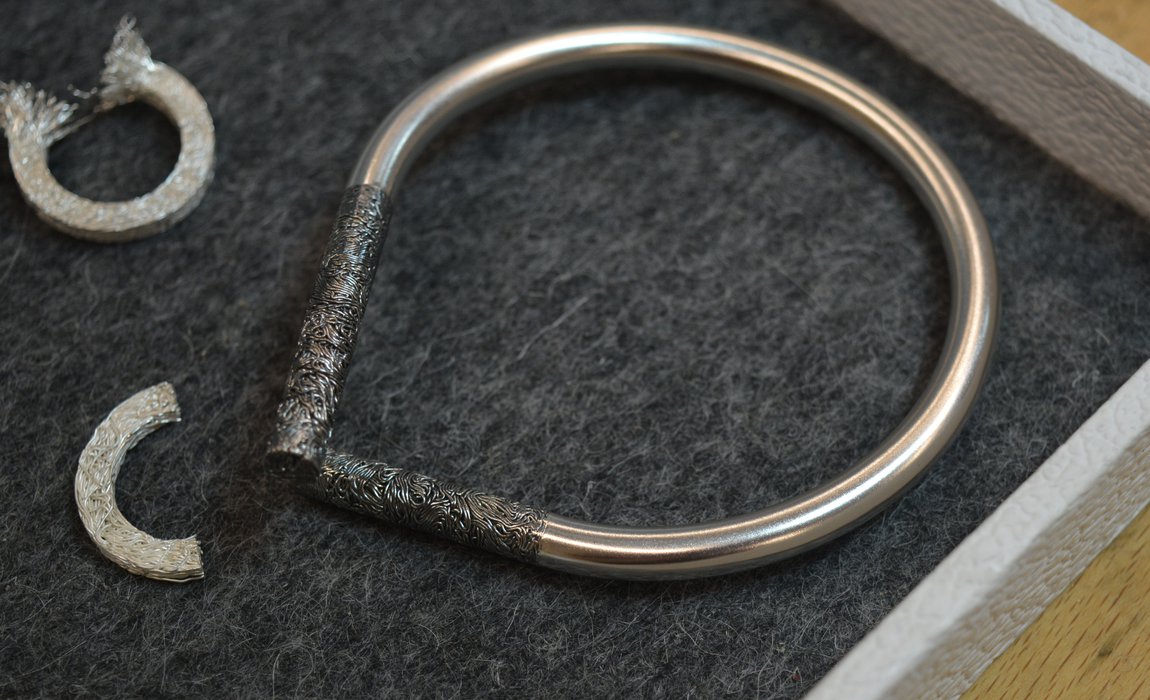Drawn + Formed: Elisavet Messi on jewellery innovation with drawn wire
Jeweller Elisavet Messi seeks to reveal the intrinsic beauty of drawn silver wire, forming and twisting it to craft her clean and minimalist designs. Each stunning final piece is deceptive in its simplicity but is created using an innovative technique developed by the jeweller herself and is underpinned by a staunch philosophy of sustainable and ethical practices.
To celebrate the exhibition Drawn+Formed: Contemporary Work with Gold and Silver Wire, the Greek-born maker lets us take a closer look at her unique process of creating jewellery, and the growing importance of sustainability in our jewellery practice – the subject of her regular short course at the Goldsmiths’ Centre. Drawn+Formed will be on show in future at the Goldsmiths’ Centre in partnership with the Worshipful Company of Gold and Silver Wyre Drawers.

Your work is described as minimal jewellery with a focus on materiality. Can you tell us more about your approach to designing your pieces?
I try to showcase the material properties in my work as much as possible. This approach often strives away from any sort of decorative elements and focuses on what the material can do by itself. The result is minimal pieces with sculptural values.
This is achieved, by compressing lengthy reams of wire into solid forms with the help of my handmade steel compressor tools.
The technique you use to create one of your pieces is unusual, if not unique to your practice. Can you describe the process?
Wire has that quality of memory, if formed and straightened again it always shows. Based on this property and the concept of turning raw materials into jewellery with minimum manipulation, my process slowly took shape.
Everything starts with the use of a lathe. I turn steel rods into precision tools that become my compression mechanisms and allow me to shape my 0.3mm wire into solid forms.
These precision tools are like a tube within a tube within a tube - if you’re fond of baking, you might liken them to cookie cutters. For example, if you are making a ring, there is one tube in the middle of the tool that defines the ring size. This sits within a bigger tube that will compress the wire, and finally there is an external tube that will hold everything in place.
Once these tools are made, I entwine the wire carefully, first by hand and then with my tweezers for accuracy. Then the wire gets placed into the mould and with the help of my hydraulic press, it results in the beautiful compressed forms that make my jewellery. This is a method that over the years that I’ve been doing it has evolved quite a lot. Recently, my samples have become a lot smaller and more defined, but the process and the materials still remain the same. Despite the fact that my work showcases minimalism, behind the scenes, it is quite an elaborate process.
The end result is small, elegant forms that may be combined with other various thickness of wire to articulate a finished piece; yet, all the overall aesthetics I am going for are relying on the complex of simplicity.
How did you invent this process, and are there any other makers that you know of that use it?
It started when my grandpa passed away, and I inherited a house in a village in the Greek countryside, in the middle of nowhere, where my grandpa was from.
This house was falling apart - it had not been lived in since the Second World War, and there were literally only two stone corners left. Although it wasn’t habitable, my dad said that he would take me to look at it, to show me where my grandpa grew up. So, we got there, and the moment I saw what was left of the house I thought oh my God, this is amazing. A tree had grown within the four walls, eventually outgrowing the house and causing the walls to fall. Even after they had fallen away, the plants had retained the shape of the house. It was almost a seamlessly perfect cube made up of a tangled tree, and I suddenly thought - why has no-one thought of this? A solid shape, made out of an organic form. This was the point that my wire concept was created.

My dad thought I was a bit crazy when I shouted “jack pot!”,and started to explain what I saw worthy in the ruins. Thankfully, as a mechanical engineer though, he understood my way of thinking even if he thought it was a bit too artsy at the time. So, after years of being his trainee, and with access to his engineering workshop, my idea of compression started to flourish.
I started developing the idea on his lathe, which is an expensive piece of machinery that works by rotating, centrifugally, any block of material around a cutting tool, allowing you to make round or tubular forms. The process was based on the same way we compress cars in order to be recycled. I watched a lot of documentaries and even visited a car recycling plant, where it was also explained to me exactly how the cars are compressed into a square form - by using two opposite presses. This made me realise what forces I will need, what will act as my side press - my wall - and how I can control the overall process. So I took a hijack that is used to lift cars, and transformed it into a mini hydraulic press, which I still have in my workshop today.
My technique, it’s not unique in the sense that I took a principle that already existed, but I just applied it to jewellery, which is quite rare. So far, I only know of one jewellery maker worldwide, in Poland, who has done something similar although it is less elaborate - he probably touched on it and then realised how long it takes, as each shape requires different tools!

What is hand-drawn wire? How is it made and where would we traditionally see it used?
Hand-drawn wire is a broadly used term for wire that has been made from scratch by the jewellery maker. It usually involves three stages: melting, rolling and wire drawing.
The first is the melting stage and creation of the alloy ingot. Say for example, you might decide you want to use 18 karat gold wire. You then need to gather your alloy percentages, usually 75% gold, 12.5% copper, 12.5% silver and melt. Once you’ve created your alloy, you end up with an ingot, which is essentially a big lump of gold. It will be quite thick and long, with one defined shape, and might look something like a pencil, or baked bread.
You then take this onto the rolling mill, which is a little like a pasta making machine, but for metal. This tool gives your shape a better definition, so that you can start refining it down. It turns your rod to more wire dimensions.
Last, but not least, is the actual drawing down process to thin and refined wire. This is achieved by the use of a drawbench, and drawplates. Each plate has a decreased sequence of holes where the wire slowly is drawn down to thinner and thinner measurements by the help of a mechanical pull force (drawbench).
The process of hand drawing wire doesn't happen very quickly. It's three stages, and with each step, from alloy to wire, you have to constantly anneal your metal to maintain its malleability. That involves heating the metal with a torch, and trying to make sure the molecules and chemistry within the metal remain happy. This is necessary in order to avoid cracks or shredding of your wire, because every time you shrink the metal, if you don’t tend to it, you can create splits, which if overlooked could make small cuts or scratches in the wearer’s skin.
It is perceived as a traditional technique, and for some is viewed as a rare skill, since refineries do satisfy the demand for wire in the market. But it is a skill that allows the maker to be in charge of their alloys and wire size. It is broadly used in filigree work and it gained popularity as a technique after the exquisite work of Giovanni Corvaja, since he is the artist behind the thinnest gold wire used in art-jewellery.
 The Golden Ratio Necklace by Elisavet Messi
The Golden Ratio Necklace by Elisavet Messi
Hand drawing wire is quite a rare skill within the jewellery industry; why do you think this is, and how can makers learn more about this technique?
The UK market broadly relies on refineries and ready to use materials. This convenience saves time and money not only for younger makers but also for established professionals. This was not the reality though a few years back, and even now, not all alloys are available to be purchased off the shelf. For everyone that would like to benefit from the technique, they can attend one of the short courses that I lead at the Goldsmiths’ Centre, called Sustainable Practice Workshops, where you will not only get hands-on experience but can also advance your knowledge further with the resources provided.
When did you decide that sustainable and ethical practices would be a focus of your jewellery business - what was the turning point for you?
I’ve been in England for nearly ten years now, but when I first arrived, I was shocked by the fact that English people recycle. Where I come from, we don’t think sustainably. During my first year at university, my flatmates would separate all of our rubbish for recycling, and I couldn’t see myself getting on board with the concept - I was too much of a Greek! But slowly, the idea grew on me.
The real turning point, however, was working for Ute Decker, an exquisite pioneer in sustainable and ethical jewellery. The very first day that I showed up at her workplace, I arrived with a takeaway coffee in my hands - which seemed very reasonable as it was a long commute. On your first day, you’re already anxious, and Ute gave me a lecture. She told me to think about the population of London, and how much plastic waste would be produced if everyone thought like me, and decided to grab a coffee in a disposable cup on their way to work. They might even get greedy and have one or two coffees throughout the day.
That was really my first proper moment of consciousness about my contribution to landfill. I decided to find out how much rubbish I could produce in a week, by collecting it in my room, and there was a lot. After that, I started being more conscious about sustainability. It’s not just the jewellery and the materials and where they come from, it’s a way of thinking that you apply to everything, like avoiding food that comes in plastic containers. It was a real turning point, and for the past five years I’ve used a reusable mug for coffee.

What advice can you offer to other makers interested in making their practice more ethical and sustainable - what are the first simple steps that they can take?
When it comes to applying sustainability to jewellery, there are so many things that you can do. For example, if you’re just starting up, recycle as much as possible. If you’re creating bespoke jewellery for clients, then ask them if they have any fine jewellery in their possession that they don’t wear and would like to recycle, and use the same gold, silver or stones to make their piece. Explain to them that every material has massive costs both for the earth and for people when it's produced.
There is a broad amount of information out there for you at ethicalmaking.org, which features research from Ute Decker, Greg Valerio and many tips from the Incorporation of Goldsmiths. You can also get gold and silver from organisations like Fairtrade and Fair Mined, which are both trying to improve the conditions of workers and give back to the community, or source non-conflict affected gemstones. If this is a bit out of reach at your stage of career, because some of these organisations require you to register or pay money, then start with recycling as much as possible, and you can even source second-hand gemstones. Now there is an issue there, in that some people believe that a blood diamond is always a blood diamond, that its footprint never goes away, even if it is reused or is secondhand. However, by using the same stone, you are at least making sure that another stone hasn’t been mined unethically for this piece of jewellery. So, it becomes personal to each individual, either as a maker, or a consumer, what you consider ethical. You need to have these conversations with yourself and you need to be honest with yourself.
 Depayse Earrings by Elisavet Messi
Depayse Earrings by Elisavet Messi
The best thing to do is just to ask the right questions. What can I do, can I alternate my choices, where I shop from? Ask your supplier whether they know where a diamond or a material is from, and what impact it has made in order to get it to the point of being sold to you. If every single maker asks this question, then the supplier will begin to ask the same questions of their source. It creates a positive chain of reactions that starts with you.
It can also create meaningful connections, and help you find your ‘tribe’. The first ever ring I sold was at my degree show, to a girl who asked me if I was using ethical materials. I explained that I was using recycled gold given to me by grandparents and friends and acquaintances, because I didn’t have a lot of money at the time. She was very happy about that, and asked me questions about whose gold the ring was made of - I gave her info about the guy that had sold me it, and it had actually been his daughter’s, who had passed away. When he found out that another young girl bought a ring made of her gold, he was very happy. It became sentimental, because sustainability can give a deeper meaning to an object.
Can you tell us a bit more about your 'One of a Kind' project, in which 30% of the proceeds of commissioned pieces are donated to charity - what inspired the idea, and how do you choose your beneficiaries?
The project is very dear to me. It pains me deeply to see people being treated unfairly and I personally can’t always financially support charitable causes. Most small makers aren’t making an extortionate amount of profit, so it will take a few years before I can donate an amount of money that will make a difference. So instead, I thought of creating a positive chain of events with my work.
I think every artist has a moment during those five or ten spare minutes at the end of the day where they have a crazy idea that isn’t going to be commercial, but is an idea that hopefully at least one other crazy person out there in the world will see and think, this is amazing. I think these ideas need to be encouraged, not shut down because they’re going to cost a lot or aren’t going to be commercially viable. Just like wire, it’s a simple material that if you look at in a different light, suddenly it becomes something more, so it’s about seeing beyond the negatives.
I have one-off projects, pieces that I will create once and never again, and they tend to be more expensive than my typical work, though I always try to be down-to-earth with my prices. So I came up with a concept where I would put my most crazy ideas out there as a one-off, and people would be encouraged to buy them because I will give the majority of the profit to a worth-mentioning cause. It means that through their purchases, clients can support me to do more creative work that isn’t purely commercial in nature. That creative, positive energy is then turned into a commitment of funds for a good cause.
Obviously, Black Lives Matter has been the talk of the town, but I don’t want to use supporting the cause as something that can be marketed, so I’ve tried to keep the project quite quiet. I leave it at the bottom of my website. Another cause that I chose to support is Diversity Role Models. We live in a very multifaceted society, where you don’t need to be stereotypically slim, golden-haired and blue-eyed to be a good teacher, firefighter, doctor, or so on. You can have short hair, piercings, or be of a different sexual orientation and from any cultural background. I think things have started to change with our generation, but people are still broadly judged on first impressions, and if I can do something to change the minds of people, so that they judge on abilities instead, I will. So the One-of-a-Kind project is about investing in other people through investing in me.

What do you feel are the biggest challenges for makers hoping to adopt more sustainable practices?
Laziness. When I first wanted to get involved in Fairtrade, I was petrified by the amount of paperwork there was for me to read, and the fact that I had to sign a contract, so I kept putting it off over and over. Then at some point, I had enough savings and I said to myself, I’m going to register, I’m going to read the contract, I’m going to sign it, I’m going to get it over with, and it took probably twenty minutes in total. Then things changed, there were new fees and as someone just starting out, that terrified me, too. I realised that I was between being petrified and lazy, and those two things are what people find as issues. It’s not the contract or the paperwork, it’s a conversation you might have with yourself where you ask yourself is this right for me, am I doing it correctly, am I doing it enough, will I lose money?
I want everyone to think of their clients as best friends - you don’t want to sell those people something that dishonours you or makes you feel that you’re not being clear nor transparent with them. So avoid being lazy, for whatever reason, and say, I’m going to do my homework so that I know how much money I have to invest in this, it might be as a little as what you spend on coffee in a month. Yes, it’s a bit of extra admin, a bit of extra effort, but just like when you go to the store, it’s easy to buy a plastic bag, but it takes five minutes to remember one from home. You need to walk that extra mile to be truly sustainable.
Do you think that the industry is engaging enough with the conversation about ethical and sustainable practices, and if not, how can both consumers and makers help draw attention to these issues?
I think times have shifted. Whereas once everyone wanted to be a brand, now everyone wants to appear to be an independent maker or business. I think the perceptions of who you are giving your money to have changed, and people are trying to make an impact with their buying habits, and that’s causing a shift in the market, and the big brands have started to adopt the habits of the smaller makers. All of a sudden, you see big brands using sustainable packaging, like paper boxes instead of luxurious leather ones, or if they are using leather, it’s vegan leather. These things are no longer associated with artists, they are no longer cool because they’re perceived as edgy. The consumer has become more selective and therefore they are following up an inevitable change. Regardless of how big or small their steps, the right push from customers can make an exceptional difference, which is why it’s so important to educate your customers. I don’t think sustainability is a trend, I think it’s an inevitability.